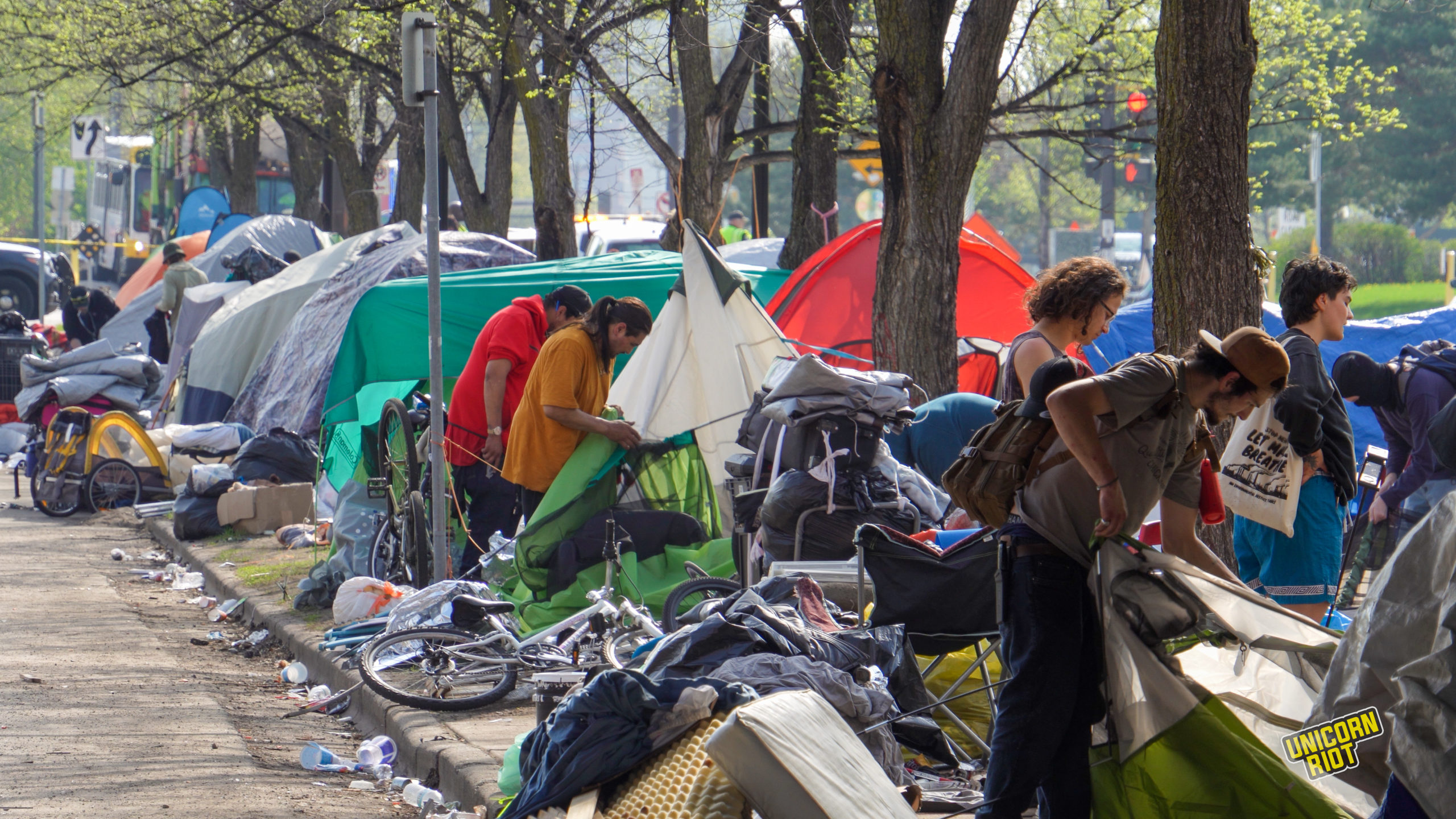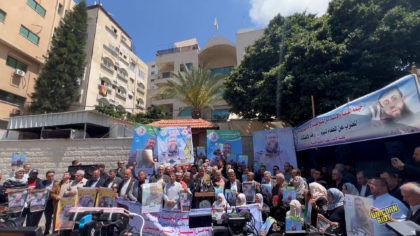Minneapolis Continues Encampment Evictions, Displacing Hundreds in May
Minneapolis, MN — During the month of May, the City of Minneapolis has been busy evicting encampments of unhoused people, displacing hundreds and throwing away many people’s only belongings. Minneapolis Police (MPD) displaced about 80 unhoused people on East Franklin Avenue in South Minneapolis on May 10. Each week since, they’ve evicted several smaller camps erected from those displaced from the Franklin Ave. sweep, continuing a punishing and deadly cycle.
“This is what he touts as his great success,” said American Indian Movement member Mike Forcia about Minneapolis Mayor Jacob Frey and homelessness. Forcia spoke to Unicorn Riot while standing in the median of Franklin Ave. amid dozens of tents and unhoused people’s property that were about to be trashed by authorities.
While on a megaphone, Forcia was heard saying “Yeah look at all this money, look at all this overtime pay. Two hundred and fifty thousand dollars.” Forcia was referring to the amount of money it takes to uproot a homeless encampment, of which can cost anywhere from $40,000 to $265,000 and includes police pay which is reported to be the largest element of expenses.
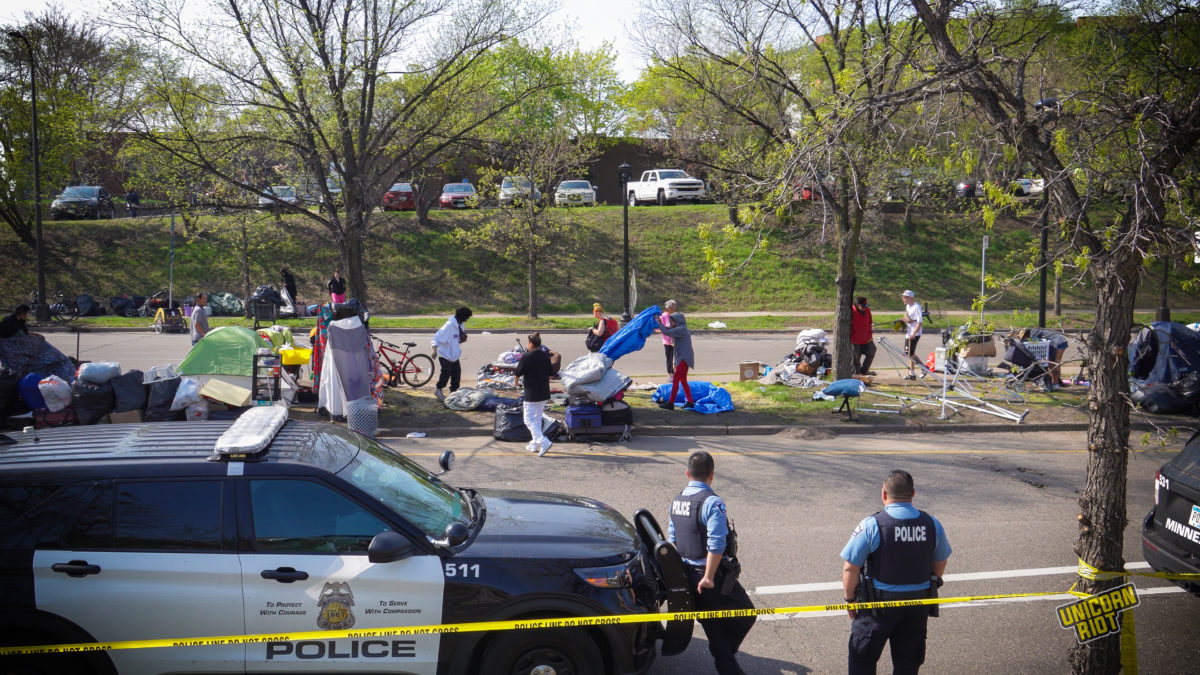
A report (pdf) from the City of Minneapolis titled A City Response to Homelessness revealed data from a “Fiscal analysis detailing encampment closure costs”:
- Prior to closure, individual encampments require routine city services costing upward of $50,000 each, annually, especially waste disposal. Ad hoc city services including public health, law enforcement, 311 support, 911 calls, etc. are not quantified.
- Closure activities range between $40,000 to $265,000 in total cost depending on conditions, with factors requiring police presence being the clearest contributor to cost.
According to the “Legislative Direct Response” report (pdf) by the City of Minneapolis, the total expenditure of the Near North encampment closure on October 6, 2022 was $265,212. The Quarry encampment closure cost $112,755 according to this report.
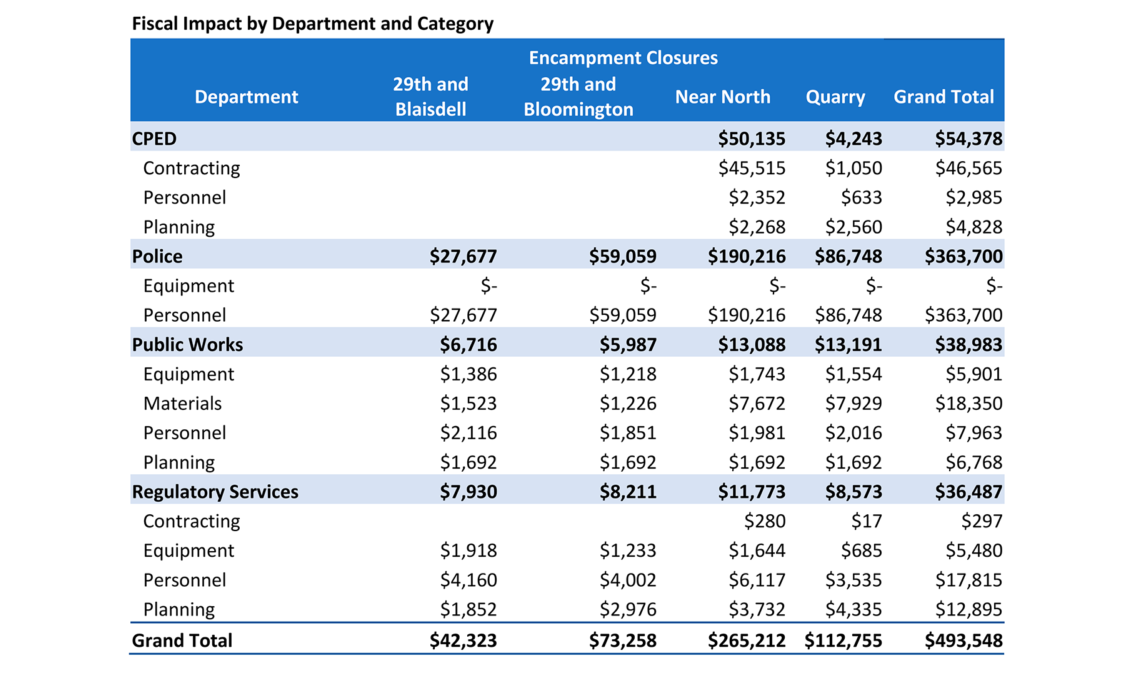
The grand total of four encampment closures from May 2022 to April 11, 2023, was $493,548. Nearly 75% of the cost was the price-tag of the police at $363,700, according to the City of Minneapolis.
Homeless-Encampment-Closures-Legislative-Directive-Response-Apr-11-2023The day before the May 10 eviction, Forcia said he was with MPD Chief Brian O’Hara and Lt. Troy Carlson as they visited the encampment and told the residents they were planning on evicting them. Forcia said O’Hara seemed surprised at the conditions of struggle that many were facing.
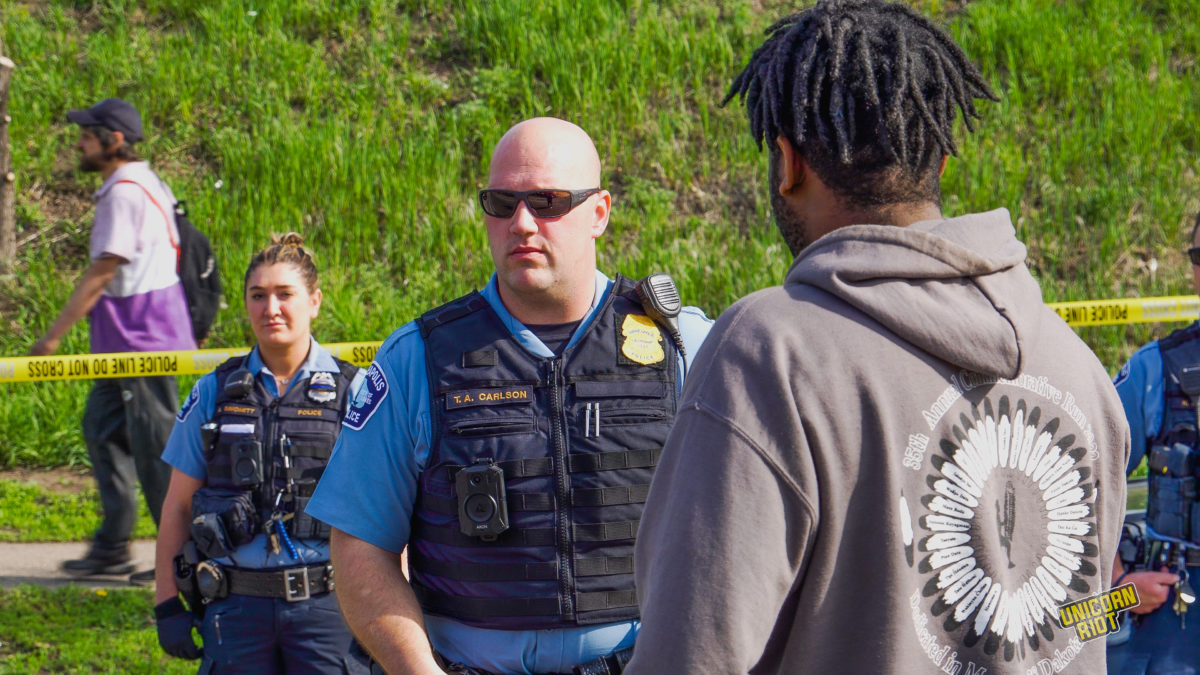
While some elected officials view the unhoused living in tents as neighbors, the city has effectively declared war on encampments with continual evictions. Many unhoused have found safety-in-numbers and have easier access to resources when living with others and forming encampment. Among a litany of issues, many on the streets view the shelter system as too punitive or have partners and/or pets they can’t or won’t be separated from.
City Minneapolis @MayorFrey celebrates Native Indigenous Month of May with
— Angry Grandma (@NicoleP32329282) May 17, 2023
4 evictions
151 houseless relatives evicted
134 Natives
88% Natives evicted
WE ARE STILL HERE AND WE NEED A SOLUTION FOR OUR PEOPLE
With rising inequality, continued neoliberal policies, and new waves of addictive drugs like fentanyl, the numbers of people struggling with homelessness in Minnesota has risen. The city of Minneapolis has seen an influx of encampments of unhoused people gathering together, notably since the 2018 Wall of the Forgotten Natives.
The sanctuary movement that rose from the ashes of the George Floyd Uprising has continued to spawn support groups that provide direct resources to those struggling to find shelter, clothes, and food. Their importance continues to grow as the negative impacts on people experiencing homelessness widen and intensify.
A report released in January by the Minnesota Department of Health and Hennepin Healthcare Research Institute —Minnesota Homeless Mortality Report, 2017-2021 (pdf) — found that the death rate of a person experiencing homelessness is three times higher in Minnesota than the general population.
Native and Black Americans were found to experience homelessness at a higher rate. The report’s key findings are as followed:
- The rate of death is 3 times higher among people who experience homelessness (PEH) in
Minnesota than the general population.- 20-year-olds experiencing homelessness in Minnesota have the same rate of death as 50-year-olds in the general population.
- Mortality across each racial and ethnic group is higher among PEH than in the general Minnesota population.
- American Indian PEH have 1.5 times higher rates of death than other PEH and 5 times higher rates of death than the general Minnesota population.
- Deaths from substance use are 10 times higher among PEH than the general Minnesota population.
- 1 in 10 substance use deaths in Minnesota are among PEH.
- 1 in 3 of all deaths among PEH are caused by substance use, especially opioids including fentanyl.
In March the Minnesota Legislature funded $50 million for the Family Homeless and Prevention Program (FHPAP) for the 2023 fiscal year, which ends on June 30, in bill HF1440. For the next two fiscal years, the new omnibus housing finance law, HF2335, funded with a controversial .25% seven-county metro sales tax, will support housing stability and rental assistance. Officials say FHPAP assistance is expected to prevent homelessness around the state. (PDF – Spreadsheet covering programs and proposals from the 2023 legislative session.)
Unicorn Riot's 2020-24 Unhoused Crisis in Minneapolis:
- Crisis of the Unhoused – Landing Page for Unicorn Riot Coverage
- Camp Nenookaasi Burns Down, Finds New Home - Feb. 29, 2024
- Camp Nenookaasi Pushes Debates in Minneapolis Around Encampments [Video] - Feb. 26, 2024
- Camp Nenookaasi Brings Minneapolis’ Policies Against its Unhoused Residents to the Forefront - Feb. 7, 2024
- Camp Nenookaasi, a Beacon of Hope to the Unhoused, Faces Eviction - Dec. 14, 2023
- ‘Wall of Forgotten Natives’ Encampment Revived After Five Years, Gets Evicted - Sept. 4, 2023
- Minneapolis Continues Encampment Evictions, Displacing Hundreds in May - May 26, 2023
- Samatar Encampment Eviction Leaves 100 Displaced Mid-Winter - January 24, 2023
- Dozens of Police Evict Quarry Encampment - January 2, 2023
- Quarry Encampment Faces Eviction in Minneapolis - December 28, 2022
- Three Encampments and Halfway House Evicted, Displacing Hundreds - October 12, 2022
- Personal Belongings Trashed as Minneapolis Encampment Evicted - July 22, 2022
- Minneapolis Community Resists Encampment Eviction - July 20, 2022
- Southside Minneapolis Encampment Faces Eviction Threat - June 28, 2022
- Eviction Defense Successful Despite Aggressive Contractors - June 9, 2022
- Uptown Streets Blocked During Protest Against Police Attack on Houseless - March 23, 2021
- Five Arrested as Minneapolis Police Attempt Raid on Near North Houseless Encampment - March 23, 2021
- Homeless Tenants Union: Unhoused Self-Advocacy in the Twin Cities - February 17, 2021
- Winter of Coronavirus: Seeking Shelter in Minneapolis During COVID–19 - December 14, 2020
- Unhoused Community Forms Tenants Union, Constituents Protest at Commissioner’s Home - November 11, 2020
- Minneapolis Prioritizing Park Sweeps Over Sheltering the Unhoused - October 29, 2020
- ‘No KKKops, No Pipelines’ Banner Dropped in Minneapolis - October 6, 2020
- Reclaimed Space Sprouts From Uprising’s Embers - September 28, 2020
- Peavey Park Sanctuary Homeless Camp Evicted in Minneapolis - September 24, 2020
- New Month Brings Added Urgency To Minneapolis’ Housing Needs - September 2, 2020
- Sanctuary Camp Residents Pressured To Move, No Housing Solution In Sight - August 22, 2020
- Minneapolis Police Sweep West Powderhorn Encampment, Pepper Spray Defenders - August 15, 2020
- Authorities Visit Loring Park Tent Encampment, Bring Eviction Scare - August 10, 2020
- Minneapolis’ Unhoused Speak Out Against Years of Evictions - August 3, 2020
- Minneapolis Park Police Displace Sanctuary Encampment - July 22, 2020

Follow us on X (aka Twitter), Facebook, YouTube, Vimeo, Instagram, Mastodon, Threads, BlueSky and Patreon.
